Despite its colorful environments filled with blocky characters who look like they fell straight out of a LEGO game, Castle Pixel’s Rex Rocket is not to be taken lightly. Bearing a plot which feels like a comedic blend between Alien and 2001: A Space Odyssey, this metroidvania in space oozes with exploding robots, melting scientists, and sentient slime monsters. To round out this action-packed adventure filled with aliens, zombies, and rogue AI’s, the difficulty is also remarkably brutal.
Rex Rocket may be one of the more challenging games out there, but you wouldn’t think so if you were to judge it by its opening act. Players take control of Captain Rexford (or Rexanna if you so choose) ‘Rocket’ Rexington, a former war hero whose fame has gradually faded away, as he journeys across his spaceship, the S.S. Montana. The first fifteen minutes or so of gameplay has little in the way of platforming and nothing at all in the way of danger, it takes a few minutes for you to even gain access to a gun, and has you running back and forth talking to various scientists and crew members while performing largely trivial tasks. Those looking to dive straight into the action might find this initial segment tedious, but it’s otherwise a great way to provide some light tutorialization while giving players access to a few early upgrades and familiarizing them with the layout of what serves as the hub area of the ship, with the cast of characters, and with the setting in general. Of course, things don’t continue to go smoothly and soon enough LAURA, the S.S. Montana’s AI, is out to kill Rex and the rest of the crew while the ship’s cargo, deceptively cute slime monsters known as terra-oozlings with the potential to rapidly terraform planets, have broken free and are infecting just about every person and machine on the ship.
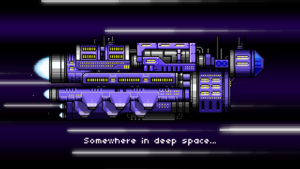 Once this game gets going, it rapidly picks up momentum. Rex can only perform normal jumps, slide down and jump off of walls, and shoot a rapid-fire laser rifle at the start, but he soon gains access to the charge shot and this leads to the defining feature of Rex Rocket’s gameplay. Rex’s jump is definitely too slippery to allow for much in the way of precision platforming on its own, but his blaster serves to balance this out. By rapidly firing downward, Rex can slow both his descent and his momentum to allow for longer, more precise jumps. As to the charge shot, it gives Rex an upward boost which can save him from an untimely demise or let him reach otherwise inaccessible platforms. Gauging jumps is a huge part of Rex Rocket and you’ll need precise timing on charge shots and rapid-fire blasts to safely navigate the many spike and acid-filled corridors of the S.S. Montana.
Once this game gets going, it rapidly picks up momentum. Rex can only perform normal jumps, slide down and jump off of walls, and shoot a rapid-fire laser rifle at the start, but he soon gains access to the charge shot and this leads to the defining feature of Rex Rocket’s gameplay. Rex’s jump is definitely too slippery to allow for much in the way of precision platforming on its own, but his blaster serves to balance this out. By rapidly firing downward, Rex can slow both his descent and his momentum to allow for longer, more precise jumps. As to the charge shot, it gives Rex an upward boost which can save him from an untimely demise or let him reach otherwise inaccessible platforms. Gauging jumps is a huge part of Rex Rocket and you’ll need precise timing on charge shots and rapid-fire blasts to safely navigate the many spike and acid-filled corridors of the S.S. Montana.
No metroidvania is complete without upgrades and this game certainly has a number of them. In addition to his standard gun, Rex finds over half a dozen subweapons on his journey, some mandatory and some optional. These weapons include a laser shotgun, a cybernetic boomerang, and, my personal favorite, a wall and enemy-piercing railgun; some of these weapons can be used to give Rex a boost while jumping, but most of them are purely useful for combat purposes and many of them can hit enemies from angles which Rex’s default weapon cannot. Instead of ammo, these subweapons share a slowly-replenishing energy bar and are balanced out by stronger weapons eating up larger chunks of the bar per shot. Other than subweapons, Rex eventually gains access to a few movement upgrades and grenades, which are of particular note because, not only can they destroy certain blocks, but they can either be placed on the ground or thrown and can instantly take out strong enemies or large groups of small enemies near them and they send out lasers in every direction upon exploding. Grenades bounce so they will simply fall off of small platforms if thrown, but learning to use them makes it much easier to take out some of the tougher enemies and bosses in the game and the post-explosion spreadshot can take out enemies without putting Rex in danger. Dozens of upgrades for health, weapon energy, and grenades are also scattered around the game and often require some remarkably dangerous platforming or a bit of puzzle solving to reach. Non-combat collectibles also exist, most notably in the form of ‘Missing Records’, vinyl records each containing a song from the soundtrack, and 90 different info nodes, some of which are purely comedic while others serve to flesh out the setting and the characters or to give some information on the various enemies. In short, it’s going to take quite a bit of time and effort if you plan to 100% this game.
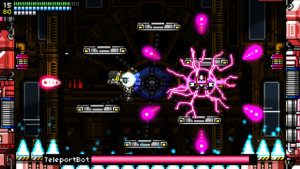
This may be a metroidvania, but it has a few unusual traits for the genre. On the normal side of things, the whole game is one big, interconnected map and the general layout of the S.S. Montana matches well enough with its outer design to make it feel like a real spaceship even if the spike-laden and laser-filled hallways are a bit on the questionable side of interior decorating. Warp points and fake walls are also present, as are optional rooms which provide alternate paths or upgrades. There is extremely little mandatory backtracking involved as the ship is divided into fairly linear sections and, other than the hub area, you never need to revisit old parts of the ship. Even the optional upgrades in each area, with the exception of one or two subweapons, can be obtained on your first time through without the assistance of late-game items. Where things move substantially farther away from traditional metroidvania territory is with the checkpointing system.
Checkpoints automatically save the game and are so frequently that it’s fairly common to see one at the entrances of several consecutive rooms. The reason for this seemingly excessive checkpointing soon becomes clear – Rex isn’t particularly good at staying alive. Even the smallest of enemies will take off several points of health while attacks from larger enemies can sometimes take off about half of Rex’s healthbar (and that’s assuming you have been actively collecting health upgrades). More importantly, the hundreds of spikes, pools of acid, and moving lasers spread across just about every room on the ship don’t just deal high damage, they instantly kill Rex just like they would the heroes of more traditional sidescrolling platformers. The generous checkpointing goes a long way towards minimizing the penalty from these frequent deaths, but it is further aided by the presence of switches; many of the longer or more difficult rooms have a shortcut blocked off by a colored laser barrier, but finding the appropriate switch will keep the barrier disabled even if Rex dies, ensuring that you rarely need to successfully navigate the harder portions of this generally-difficult game more than once even if you die midway through a room.
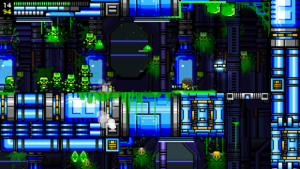 One aspect of the game which I think definitely needs to be addressed in this article is energon. Energon can sometimes be dropped by enemies, but it’s more commonly found scattered around the map in small squares or large containers. So, just what is it for? Well, Rex Rocket actually has a lives system in place and, just like coins in Super Mario Bros. and hundreds of other platformers, energon grants a 1-up if Rex collects 100 of them; big containers often are placed in hard-to-reach or dangerous locations, but they instantly give Rex 100 energon, making them for all intents and purposes 1-ups. Rex starts with an impressive 15 lives and large energon containers are common enough that at one point I had over 40 lives, but in the original version of the game running out of lives came with the severe penalty of sending you back to the main hub and wiping all progress you made in the newest section of the ship. However, a patch which was rolled out in December 2014 removed this penalty and now running out of lives simply results in a Continue screen from which you can restart at the most recent checkpoint with a fresh set of 15 lives with no progress lost; I’ve seen some complaints floating around about this change not being an optional toggle, but I personally have absolutely no issue with it as I think such a penalty only serves to add tedium rather than actual challenge and is counterproductive to encouraging exploration and risk-taking. What this all ultimately means is that the lives system is now completely arbitrary and, once again just like Mario’s coins, energon has become pointless beyond serving to guide the player along paths or for obtaining achievements, but this was definitely a step in the right direction for this game and I’m glad to see that Castle Pixel was willing to change an unsatisfying system rather than hold onto it with a deathgrip.
One aspect of the game which I think definitely needs to be addressed in this article is energon. Energon can sometimes be dropped by enemies, but it’s more commonly found scattered around the map in small squares or large containers. So, just what is it for? Well, Rex Rocket actually has a lives system in place and, just like coins in Super Mario Bros. and hundreds of other platformers, energon grants a 1-up if Rex collects 100 of them; big containers often are placed in hard-to-reach or dangerous locations, but they instantly give Rex 100 energon, making them for all intents and purposes 1-ups. Rex starts with an impressive 15 lives and large energon containers are common enough that at one point I had over 40 lives, but in the original version of the game running out of lives came with the severe penalty of sending you back to the main hub and wiping all progress you made in the newest section of the ship. However, a patch which was rolled out in December 2014 removed this penalty and now running out of lives simply results in a Continue screen from which you can restart at the most recent checkpoint with a fresh set of 15 lives with no progress lost; I’ve seen some complaints floating around about this change not being an optional toggle, but I personally have absolutely no issue with it as I think such a penalty only serves to add tedium rather than actual challenge and is counterproductive to encouraging exploration and risk-taking. What this all ultimately means is that the lives system is now completely arbitrary and, once again just like Mario’s coins, energon has become pointless beyond serving to guide the player along paths or for obtaining achievements, but this was definitely a step in the right direction for this game and I’m glad to see that Castle Pixel was willing to change an unsatisfying system rather than hold onto it with a deathgrip.
 One thing which never fails to win me over is well-executed variety and Rex Rocket has variety in just about every way possible. There are a few staple enemies which appear all over the game, such as the terra-oozlings themselves and murderous flying ‘helper bots’, but each area introduces plenty of new, thematically-appropriate foes. The barracks are overcrowded with infected soldiers hiding behind shields, shooting bullets from behind bunkers, and piloting tanks, the engine room has flying dragons, hidden crushers, and several other nasty enemies, and the vents and other ‘behind the scenes’ areas of the ship are completely flooded with slimes, slime bats, and slime zombies, most of which have ways of creating even more slimy monstrosities. Bosses are often massive and have plenty of attacks on top of the fact that they either become significantly more aggressive or add in a new twist when they get lower on health. The actual platforming also runs the gamut; one sequence has Rex piloting a giant mech through swarms of helper bots, another area gives him laser-spewing support pods with short lifespans, yet another segment has him chased by a giant laser, and the platforms themselves come in just about every form including conveyor belts, spinning wheels, disappearing blocks, dropping platforms, and more. There are even angled reflectors which bounce around Rex’s shots, sometimes to hit enemies and sometimes to activate switches while Rex is walljumping over a pit of spikes. If there is one thing you can be sure of, it’s that Rex Rocket never feels like it overstays its welcome.
One thing which never fails to win me over is well-executed variety and Rex Rocket has variety in just about every way possible. There are a few staple enemies which appear all over the game, such as the terra-oozlings themselves and murderous flying ‘helper bots’, but each area introduces plenty of new, thematically-appropriate foes. The barracks are overcrowded with infected soldiers hiding behind shields, shooting bullets from behind bunkers, and piloting tanks, the engine room has flying dragons, hidden crushers, and several other nasty enemies, and the vents and other ‘behind the scenes’ areas of the ship are completely flooded with slimes, slime bats, and slime zombies, most of which have ways of creating even more slimy monstrosities. Bosses are often massive and have plenty of attacks on top of the fact that they either become significantly more aggressive or add in a new twist when they get lower on health. The actual platforming also runs the gamut; one sequence has Rex piloting a giant mech through swarms of helper bots, another area gives him laser-spewing support pods with short lifespans, yet another segment has him chased by a giant laser, and the platforms themselves come in just about every form including conveyor belts, spinning wheels, disappearing blocks, dropping platforms, and more. There are even angled reflectors which bounce around Rex’s shots, sometimes to hit enemies and sometimes to activate switches while Rex is walljumping over a pit of spikes. If there is one thing you can be sure of, it’s that Rex Rocket never feels like it overstays its welcome.
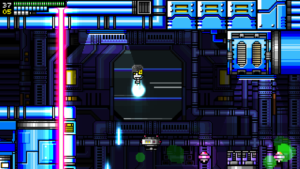 Unfortunately, variety also means that you sometimes end up with segments which just aren’t very fun. The most notable of these involves the laser chase sequence I mentioned earlier, specifically the second of these sequences. Though this is a very challenging game, it rarely feels unfair and, even with the demanding platforming, I made it through most of the game with one or two deaths every now and then. The second laser chase sequence is one of those rare occasions where the difficulty feels like it dips into unfair territory. Not only does this sequence involve plenty of precision platforming with very few chances to stop or slow down, but the platforming is made considerably less fun by the presence of floating mines. These mines explode into a spread of bullets when hit, just like Rex’s own grenades, and any one of these bullets will almost certainly knock Rex straight into a spike on contact. In this particular section, these mines are placed between nearly every set of platforms right where you would generally want to give Rex a boost with a downward charge shot, making platforming which was already remarkably difficult to perform while under time pressure even more difficult. This is to say nothing of the several other enemies scattered through this area, any of which will almost certainly kill Rex with a single hit by knocking him off a platform or simply delaying him long enough for the laser to catch up to him. It’s a section which would be difficult even on its own, but the tight time pressure made it feel like it demanded outright memorization in parts to make it to the end. There are a few other balance issues, the handful of slime-infested interior segments have so many enemies that it’s almost impossible to get through them without taking a decent amount of damage, one room with moving platforms and laser snipers simply feels boring, and the generally high damage from enemies makes the very early parts of the game surprisingly difficult, but this sequence in particular was the only time when I felt outright frustrated with the game and, excluding two extremely difficult and completely optional sections which lead to some rather fancy upgrades, I very well may have died more in this one sequence than in the rest of the game combined as I went into it with over 40 lives and came out with under 20.
Unfortunately, variety also means that you sometimes end up with segments which just aren’t very fun. The most notable of these involves the laser chase sequence I mentioned earlier, specifically the second of these sequences. Though this is a very challenging game, it rarely feels unfair and, even with the demanding platforming, I made it through most of the game with one or two deaths every now and then. The second laser chase sequence is one of those rare occasions where the difficulty feels like it dips into unfair territory. Not only does this sequence involve plenty of precision platforming with very few chances to stop or slow down, but the platforming is made considerably less fun by the presence of floating mines. These mines explode into a spread of bullets when hit, just like Rex’s own grenades, and any one of these bullets will almost certainly knock Rex straight into a spike on contact. In this particular section, these mines are placed between nearly every set of platforms right where you would generally want to give Rex a boost with a downward charge shot, making platforming which was already remarkably difficult to perform while under time pressure even more difficult. This is to say nothing of the several other enemies scattered through this area, any of which will almost certainly kill Rex with a single hit by knocking him off a platform or simply delaying him long enough for the laser to catch up to him. It’s a section which would be difficult even on its own, but the tight time pressure made it feel like it demanded outright memorization in parts to make it to the end. There are a few other balance issues, the handful of slime-infested interior segments have so many enemies that it’s almost impossible to get through them without taking a decent amount of damage, one room with moving platforms and laser snipers simply feels boring, and the generally high damage from enemies makes the very early parts of the game surprisingly difficult, but this sequence in particular was the only time when I felt outright frustrated with the game and, excluding two extremely difficult and completely optional sections which lead to some rather fancy upgrades, I very well may have died more in this one sequence than in the rest of the game combined as I went into it with over 40 lives and came out with under 20.
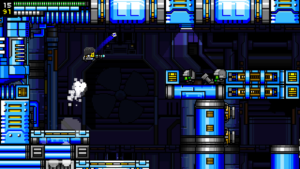
To wrap things up on a more positive note, the aesthetics and general tone here are fantastic. There is a massive disconnect with the often-comedic dialogue and the cartoon-like character designs on one side and bodies lying in puddles of blood and scientists stuck to the walls with slime and slowing dissolving to create skeletal zombies on the other, but this works in the game’s favor and gives it a quirky charm with a streak of black humor. The ship itself has a very impressive amount of work put into it with a distinctive look for each region and tons of little graphical touches placed into the background of every room which don’t get in the way of the platforming. Small warning lights or other signs are also often placed on the floor or the walls to hint at nearby danger without breaking the aesthetic. Though the artistic style of the enemies and characters doesn’t result in much room for detail, NPC’s and enemies alike look fine and have great animation and several of the larger bosses are impressive to see in motion.
Rex Rocket is one of the more linear metroidvanias out there and sometimes it gets a bit too difficult for its own good. However, the vast majority of the game is overflowing with collectibles to find, challenging and varied platforming, charming characters, and plenty of action to make it well worth checking out.